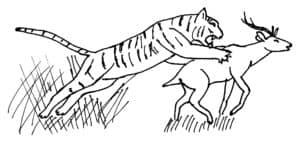One day, a boy was sitting in the shade of a large willow tree, playing his flute. He had been making a habit of this lately as the days had been very warm and he wanted to do nothing more than sit quietly in a cool shady spot. Under the willow tree was a quiet and secluded spot as the branches hung low to the ground, yet allowed any breeze to enter to keep him cool. On this particular day, the boy was quietly playing a simple tune while sitting under the willow tree.
After a while he set his flute down and listened to the birds sing their songs. At first, he could only hear the cacophony of all the different types of birds. He continued to listen and was then able to distinguish several different songs from different types of birds, the warbler, the finch, the swallow, and the lark. As he listened to the birds, he became aware of something else; a non-bird sound. The boy crept to the edge of the willow and slowly parted the leaves. He was looking out into a small meadow in which he could see a deer. The deer seemed nervous, looking around, barely taking time to nibble at the tender late-spring grass.
The boy wanted a better view, so he quietly climbed up into the willow and out onto a sturdy branch. He looked out and spotted the deer still there.  From his new vantage point, the boy could also see a tiger in the tall grass slowly approaching the deer. Patiently, the tiger stalked the deer until finally, he pounced upon the deer killing it almost instantly. The boy was both thrilled at seeing the tiger’s success and saddened by the deer’s death. As he watched the tiger drag the deer away from the clearing, the boy realized that what was good for the tiger was bad for the deer.
From his new vantage point, the boy could also see a tiger in the tall grass slowly approaching the deer. Patiently, the tiger stalked the deer until finally, he pounced upon the deer killing it almost instantly. The boy was both thrilled at seeing the tiger’s success and saddened by the deer’s death. As he watched the tiger drag the deer away from the clearing, the boy realized that what was good for the tiger was bad for the deer.
How does this story relate to Tai Chi Chuan? It can all be summed up in the last sentence of the story, “…the boy realized that what was good for the tiger was bad for the deer.” In other words, rarely is anything all good or all bad. It depends upon your point of view! Still don’t see the connection to Tai Chi Chuan? Well, read on and I’ll try to explain.
Yin and Yang Energies
One of the philosophical underpinnings of Tai Chi Chuan is the concept of yin and yang energies. They complement each other. Neither is better than the other. In fact, both are necessary. Take a look at the symbol below. This is the Tai Chi symbol – you have probably seen it before. The white areas represent yang energy and the black areas yin energy. Notice that when the yin energy is at its maximum, there is still a little bit of yang energy present as represented by the white dot. The reverse is true when yang energy is at its maximum. So, things never become all yin or all yang; neither are they ever all good or all bad. As I explained in an earlier post about An Old Man And His Son, there is no reason to get too excited when things are not as you think they should be.
Remember how I said that yin and yang complement each other? Actually, they not only complement each other, one can’t exist without the other. Think about any number of opposites – day/night, male/female, beautiful/ugly, inside/outside, hard/soft just to name a few. Let’s use beautiful/ugly as an example. If something (a person, car, flower, etc.) is considered beautiful, this is meaningless unless we also have the concept of ugly. Otherwise everything is beautiful, or put another way everything is considered the same since it wouldn’t make sense to have the concept of just beautiful without its opposite. (Here is a link that explains how Yin Yang energies relate to Traditional Chinese Medicine (TCM), which I will not explain in this post.)
Tai Chi Chuan and Yin and Yang Energies
Still don’t see the connection to Tai Chi Chuan? It will help if I explain another yin-yang pair. I mean the opposites of substantial and insubstantial, or full and empty. In Tai Chi Chuan, we are constantly shifting our weight from one foot to the other. Often, our weight is almost entirely on one foot (sometimes completely on one foot) with little to no weight on the other foot. The foot and leg with all (or most) of the weight on it is considered “substantial” or “full”. The other foot and leg is “insubstantial” or “empty”. Weight shifts, or changing our feet and legs from substantial to insubstantial should be a conscious decision. In fact, one can feel (and should pay attention to) one leg becoming substantial while the other becomes insubstantial.
It isn’t only the legs! While performing Tai Chi Chuan, we are changing the position of our limbs, and body in general.